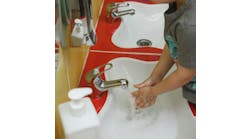For many parents, the school environment is synonymous with more trips to the doctor's office, especially during peak cold and flu season. Schools can take a few simple steps to reduce student and staff absenteeism, and create a healthier and safer environment. The first step is in the washroom.
According to the Centers for Disease Control and Prevention (CDC), the most effective way to prevent illness is to wash your hands. Unfortunately, most adults, let alone children, do not wash their hands for the recommended 25 to 30 seconds. Designing restrooms that encourage children and adults to wash their hands properly should be a priority for schools. If a restroom smells bad or is not well-maintained, people tend to make a hasty exit. Poorly maintained restrooms also increase the likelihood of accidents, vandalism and other inappropriate behavior.
Clean hands
Some germs may be found on toilet seats, but researchers say the risk of contamination there is low. Wet sink areas are a more likely place for germs to multiply. Most of the culprits are things we probably do not think about.
Dr. Charles Gerba, a microbiologist at the University of Arizona, Tucson, has made a career of testing germs and bacteria in kitchens and bathrooms. He has tested school surfaces, and found playgrounds and classrooms to be the hangout for invisible microbes like staphylococcus, E. coli and coliform. Consider all the items a child touches after he or she sneezes — and then how many students also touch those things — and it's clear how illnesses can spread quickly.
Schools need to make a greater effort to educate students on the importance of hand washing as the best defense against spreading infections. The good news is that hand-washing lessons have been making its way into classrooms to keep students, teachers and their families healthier. A teaching aid for hand washing, similar in concept to the sugar tabs dentists use for brushing teeth, can be a fun and effective way for educators to demonstrate proper hand washing and cleaning. Students spread tiny “germs” on their hands as if they were applying lotion, and after washing their hands they can see the remaining “germs” glowing under a fluorescent lamp.
Better designs
Creating a comfortable and user-friendly washroom environment is a critical and often overlooked aspect for encouraging better hygiene habits. Students won't keep their focus on good hygiene if they feel uncomfortable in washrooms, or the facilities themselves are dirty.
Facility planners must consider traffic volume and flow to keep washrooms looking and performing their best. For example, if soap runs out frequently, even those who have made hand washing a habit cannot properly wash away dirt and germs. Easy retrofits can make a big difference in some cases.
School restrooms require fixtures and accessories that can accommodate heavy traffic. Schools should select durable, large-capacity products that can handle abuse. The installation should take vandal-prone students and maintenance issues into account. Napkin and tissue dispensers that have a hidden locking mechanism can help prevent tampering. Accessories and plumbing should be recessed or built into the wall as much as possible to avoid potential damage, as well as save space. Mounting toilets, partitions, waste receptacles and sinks on walls, rather than floors, can improve maintenance and keep restrooms more sanitary.
Providing too few hand-washing stations can lead to problems. Solid-surface lavatory systems are an effective way to maximize space in today's corridor-style washrooms, as well as reduce installation and maintenance costs. These wall-mounted, group lavatory systems have fewer connections than individual china lavatories and the continuous bowl surface makes cleaning fast. The primary benefit is that group hand-washing units can accommodate more users. Up to three people can use each lavatory system at the same time.
This design also keeps water in the bowl, rather than on the floor, helping keep floors dry and safe. Newer solid-surface materials resist burns, scratching and denting, and graffiti can be scrubbed away.
Deep-bowl washfountains are another group hand-washing fixture well-suited for many school applications, such as art classes and locker rooms, and are available in heights that accommodate smaller children.
In addition to functionality, schools need to pay attention to enhancing the appearance of restrooms. Here are a few ways to keep washrooms looking their best:
-
Involve students
If students participate in revitalizing restrooms by painting murals or helping update outdated facilities, they will take pride in maintaining their appearance.
-
Brighten up
White walls are uninviting and boring, and it's tough to keep them white. Warm up restrooms with bright colors on walls, sink surfaces and toilet partitions. Better lighting also can make restrooms look cleaner.
-
Deter graffiti
Darker colors hide marks, and solid phenolic partitions and accessories are resistant to graffiti and scratching. Stainless steel also is durable. Choose surfaces that can be wiped clean easily.
-
Reduce waste
Replacing paper towels with hand dryers eliminates paper clutter and helps keep restrooms more sanitary.
Battling germs
Another way to reduce germs is to install sinks in classrooms. They are a convenient way to encourage more frequent hand washing, and teachers can monitor sink use more effectively. Durable solid-surface classroom sinks are available with integrated features, such as built-in drinking fountains, soap dispensers and waste receptacles to keep the sink area tidy.
Specifying products with germ-resistant features is another powerful tool. Some antimicrobial agents are being built into plastics and textiles for many consumer and industrial products, and they help keep surfaces fresher between cleanings. The healthcare and foodservice industries have embraced this added cleanliness, and many products are being developed for educational facilities.
It stands to reason that if children touch fewer surfaces, the transmission of germs is reduced. Touch-free faucets are a good option to incorporate into hand-washing stations. Foot-activated or infrared-controlled faucets also are more convenient, especially for younger children who may have difficulty operating traditional knobs. Soap dispensers and hand dryers also are available with motion sensors. Removing entry/exit doors can eliminate another potential hot spot for germs. Maze-style entry/exits also improve the ability to supervise restrooms.
Clean, well-designed washrooms can help provide a safe and healthy learning environment. Whether making a few updates or designing new restrooms, schools should seek to create spaces that encourage good hygiene and are easy to use and maintain.
Wilke is a senior product manager for Bradley Corporation, Menomonee Falls, Wis., a manufacturer of plumbing fixtures, washroom accessories, partitions, emergency fixtures and solid plastic lockers.

